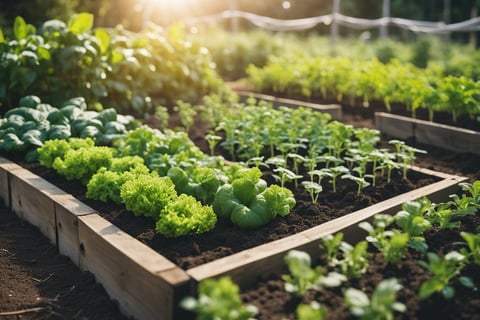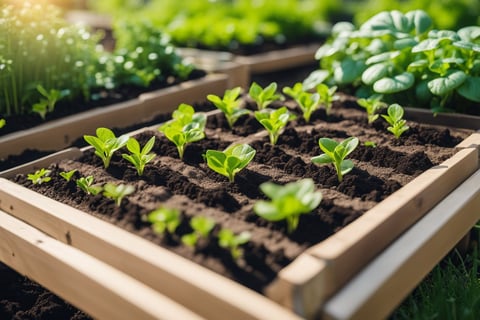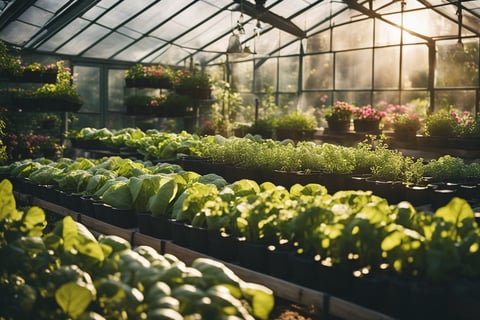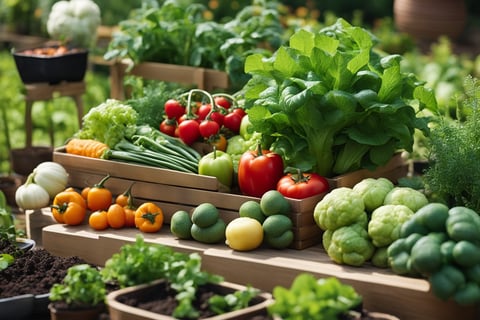Beginner's Guide to Growing Food: Simple Gardening Tips to Start Today
2/19/20255 min read
Starting a garden for the first time might seem like a big task, but it can be an exciting and rewarding experience. Gardening for food not only provides fresh produce but also saves money and promotes a healthier lifestyle. Anyone can grow their own food with just a little space, some basic tools, and a bit of guidance.
For beginners, the key is to start simple. Choosing easy-to-grow crops that suit the local climate makes the process smoother. Vegetables such as tomatoes, lettuces, and herbs are often ideal for newcomers, as they are forgiving and yield quick results.
Working with nature turns gardening into a fun and educational journey. Watching seeds sprout and produce food fosters a deeper appreciation for what ends up on the plate. As the garden flourishes, beginners gain confidence and skills, opening the door to more adventurous growing ventures.
Getting Started with Gardening
Starting a garden involves selecting a suitable location, assessing soil quality, and choosing the right vegetables to plant. Understanding these foundational steps can set the stage for a successful gardening experience.
Choosing the Right Location
Selecting the right spot for a garden is crucial. It should receive at least 6-8 hours of direct sunlight daily, as most vegetables thrive in sunny environments. Vegetables like tomatoes and zucchini need more sun, while leafy greens like lettuce and spinach can tolerate some shade.
Avoid areas prone to strong winds or that frequently flood. Proximity to a water source can make regular watering easier. Check the USDA hardiness zone for your region using the USDA Hardiness Zone Map, which can provide guidance on what plants grow best in your area. This helps in choosing between cool-season and warm-season vegetables.
Understanding Soil Quality
Soil quality plays a vital role in plant growth. Good soil should be well-draining, rich in organic matter, and have the right pH level for the plants chosen. Conducting a soil test is recommended to determine pH and nutrient levels. This can guide amendments like compost or specific fertilizers.
Add organic matter such as compost or well-rotted manure to improve soil structure and fertility. Understanding local soil types helps decide what amendments or treatments might be necessary. Peas, radishes, and carrots prefer loamy soil, while other vegetables might need more specific conditions.
Selecting Your Vegetables
When choosing vegetables, it's important to consider regional climate and personal preferences. Beginners might start with easy-to-grow options like radishes, lettuce, and green beans. These can provide a quick and rewarding harvest.
For those in warmer climates, tomatoes, zucchini, and herbs could be ideal, while in cooler areas, spinach and beets might thrive. Purchasing high-quality seeds ensures more robust plants and better yields. Be mindful of the planting season; cool-season vegetables are best planted in early spring or fall, while warm-season varieties require the heat of late spring and summer.
Creating a Thriving Garden
Establishing a productive garden involves careful soil preparation, strategic planting, and consistent maintenance. Healthy soil and proper planting techniques are crucial for growth, while regular upkeep ensures a bountiful harvest.
Preparing the Soil
Getting the soil right is the first step. A healthy garden starts with healthy soil, rich in nutrients and balanced in pH. Adding compost or other forms of organic matter boosts soil quality and improves structure. A sunny spot ensures plants get enough light.
Testing the pH level is a smart move; most veggies prefer a slightly acidic to neutral pH around 6-7. Adjusting the nutrient content is crucial for supporting robust plant growth. Using natural fertilizers can replenish essential nutrients. Proper tools like rakes and hoes can make soil preparation more efficient, ensuring it’s loose and aerated.
Planting Your Seeds and Seedlings
For successful planting, timing and spacing matter. Start with quality seeds or healthy seedlings. Whether you're direct sowing seeds or setting out seedlings, pay attention to seed depth and spacing. Some plants flourish with companion planting; for instance, tomatoes and basil benefit each other's growth.
Plant in rows or blocks, whichever suits your space and preference. Use a planting guide to match plants with their ideal conditions. As seedlings establish, mulching with organic materials can help retain moisture and suppress weeds. Strategic planning translates to more abundant and healthy produce.
Maintaining Your Growing Plants
Maintaining plants involves regular care. Offering consistent water, ideally in the morning, helps avoid evaporation and disease. Mulching helps maintain moisture and reduce weeds. Watch for pests and address issues promptly, perhaps incorporating natural pest control methods.
Keep pathways clear and trim back overgrowth to maintain airflow. Periodic feeding with a balanced liquid fertilizer can boost growth. Regularly inspect plants for signs of distress or disease. With attentive care, home gardening yields rewards in fresh organic food.
Tips and Techniques for Success
Gardening for food can be rewarding and nourishing. Key aspects include proper watering, managing pests and diseases, and timing your harvest to enjoy fresh produce. These tips ensure a thriving vegetable garden.
Watering and Irrigation
Water is crucial for healthy plant growth. Using drip irrigation can conserve water and deliver it directly to the roots, helping reduce water waste. New gardeners often find it beneficial to water early in the morning or late in the afternoon to prevent evaporation loss.
Checking the soil moisture regularly will help avoid overwatering or underwatering. A simple way to do this is to insert a finger into the soil. If it feels dry at about 2 inches deep, it’s watering time.
Pests, Weeds, and Diseases
Protecting your garden from pests and diseases is essential. One way to deter pests naturally is by planting marigolds. They’re known to help repel certain insects. Crop rotation can also limit disease by not planting the same family of vegetables in the same spot each year.
Introducing beneficial insects like ladybugs can help control aphids. Using organic or homemade pest solutions supports a healthy garden environment, keeping chemicals at bay. Regularly inspect leaves for signs of diseases, as catching issues early makes them easier to manage.
Harvesting and Enjoying Your Produce
Knowing when to plant vegetables is key to a timely harvest. Stagger plantings to enjoy a consistent food supply. Harvest veggies like lettuce while still tender for the best flavor.
Signs of ripeness include bright color and firm texture, varying by plant. Picking produce regularly encourages plants to keep producing. Not only does harvesting improve taste, but it also enhances physical health by ensuring the freshest nutrients from garden to table.
Composting remains a favorite tip among seasoned gardeners as it provides essential nutrients back to the soil, boosting future plantings. Enjoying homegrown food offers both physical and mental health benefits, connecting growers to their environment.








Harvest
Explore gardening tips, recipes, and pantry ideas.
Disclaimer
© 2025. All rights reserved.
Our blog is reader-supported. When you buy through links on our site, we may earn an affiliate commission
